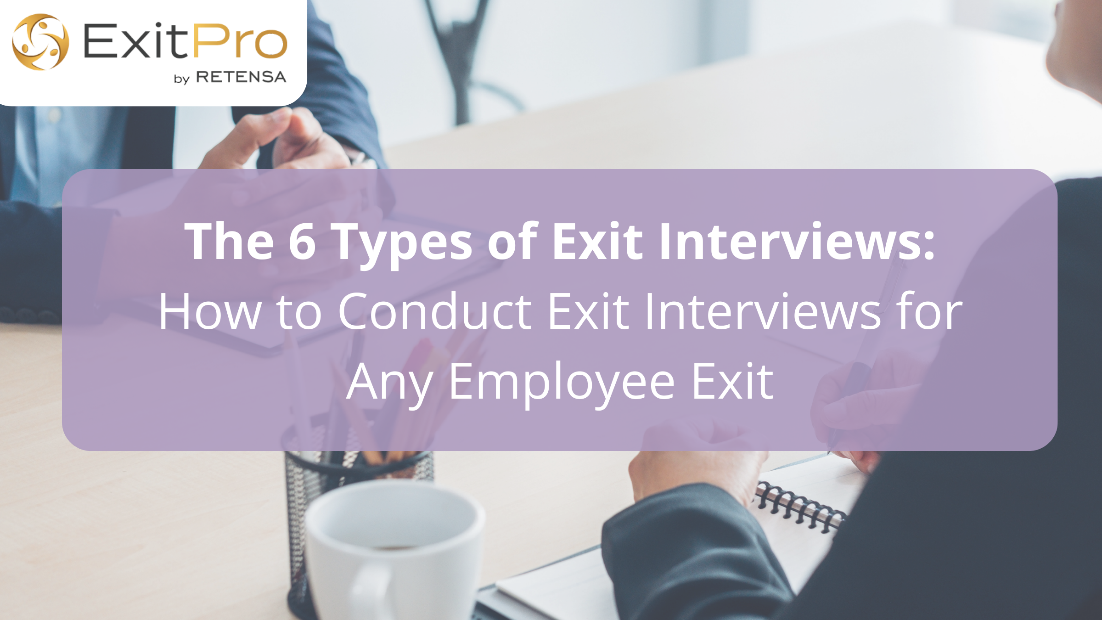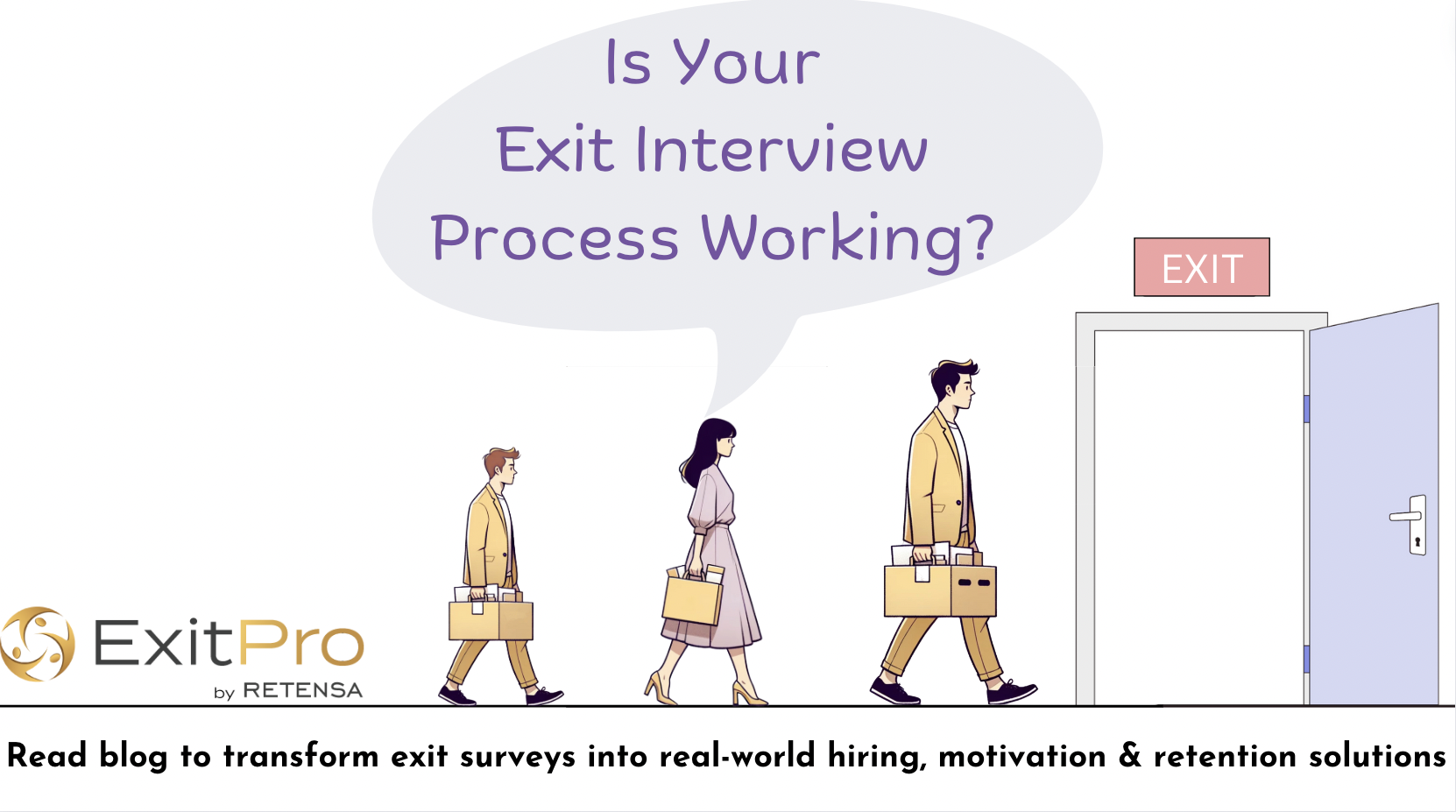How do you conduct exit interviews in your organization?
Did you know that the questions you ask and the person who conducts the exit interview can influence how effective the interview is? The Exit Interview Survey helps leaders gather the feedback needed to predict employee turnover and improve retention, but only if you actually get the answers. You can ask the right exit interview questions using the wrong medium and completions rates will languish at 20% or 30%. Leverage the right combination of exit interview type and use the answers to improve the employee experience in your organization to achieve 80% to 90% completion rates.
In this exit interview expert article, we will look at the main types of exit interviews, who should conduct exit interviews, and when to use that exit interview type and when to avoid it.
The 6 Types of Modern Exit Interviews
There are 6 different ways to conduct exit interviews in the modern workplace:
| Exit Interview Type | Exit Interview Definition |
When to Use this Exit Interview | When to Avoid this Exit Interview |
|---|---|---|---|
 Email Exit Interview Email Exit Interview |
When the interviewer sends the exit interview questions to the interviewee to their work or personal email account. Typically sent via exit interview software, responses are automatically collected and correlated to the separating employee demographics, making it easier to identify trends and patterns in the data. |
|
|
 SMS Text (Mobile) Exit Interview SMS Text (Mobile) Exit Interview |
An SMS text interview or mobile phone exit interview is where the HR team reaches out to the departing employee through text message to an employee’s mobile phone. While this method is convenient, there may be limits on the number of questions or response options, thus it may not provide as much detail as the other survey methods. |
|
|
 Kiosk Exit Interviews (QR Codes) Kiosk Exit Interviews (QR Codes) |
The departing employee is given access to a link and is asked to take the exit interview on the company's site, either via a tablet, dedicated computer, or QR Code link. This type of exit interview is increasingly popular due to its convenience, cost-effectiveness, and ability to collect responses in real-time in remote locations. |
|
|
 Live Voice Exit Interviews Live Voice Exit Interviews |
Phone interviews, or live voice-based interviews, are exit interviews where someone from the company or a third party, reaches out to the departing employee over the phone. The Exit Interview is then completed over the phone through the guidance of the interviewer. This method provides a more personalized experience as the interviewer takes their time, probes to ask additional questions and gain clarity. Live Voice Interviews are captured and adjust in real-time to include drill-down questions or options based on the employee’s responses. They capture detailed feedback from employees and hold the employee’s attention to complete the entire survey with less inclination to skip questions or drop out |
|
|
 In-person Exit Interviews In-person Exit Interviews |
The departing employee and the interviewer engage in a one-on-one conversation. Typically performed by onsite Human Resources Staff, or less commonly the manager. This method of exit interview allows for a two-way conversation and the ability to read non-verbal cues. |
|
|
 Interactive Voice Response (IVR) or Chat-based Exit Interviews Interactive Voice Response (IVR) or Chat-based Exit Interviews |
A phone number or chat room is given with prompts to answer questions to an automated attendant who replies via prompt. |
|
|
| Exit Interview Type | Exit Interview Definition |
When to Use this Exit Interview | When to Avoid this Exit Interview |
Related Article: How to Improve Exit Interviews: The 8 Exit Interview Questions to Always Include
It’s important to consider that outsourcing exit interviews to a third-party provider can offer a neutral and safe space for the departing employee to speak candidly without fear of reprisal or bias. The third-party provider brings an informed perspective and objective insights into the exit interview process, which can help to identify areas for improvement in the company’s culture, policies, or practices.
Now that you know the different types of exit interviews you can conduct, let’s look at why you should conduct an exit interview in the first place.

The Purpose of the Exit Interview (Why conduct an Exit Interview?)
The main purpose of an exit interview program is to gather employee feedback consistently across the enterprise, on the overall employee experience, and identify opportunities to reduce future employee turnover. The first step to improve employee retention is to examine exit interview reports. Other purposes of exit interviews include:
1. Understand Leadership Styles and Their Effectiveness
Sometimes it can be hard to spot problems in the management style of your organization. Effective exit interviews will help you uncover such problems. Given that a large number of employees quit their jobs to get away from their manager, finding out about managerial issues and fixing them should be a priority.
2. Clarify What Employees Think About Their Workplace
When employees leave your company, they are more likely to be forthcoming about their experiences. By asking the right exit questions, and using the right exit interview template you can find out how employees feel about their work in your organization. Is it fulfilling and challenging? Do they have the right tools to complete their work effectively? How was their experience with supervisors and managers?
3. Learn About Salaries and Benefits from Competing Companies
One of the main reasons why employees leave their workplace is because of inadequate compensation. Conducting an exit interview can help you know what competitors are paying their staff, so you can improve your compensation and benefits packages.
4. Uncover Any HR Related Issues
When conducted effectively, an exit interview will help you uncover HR problems that you can address to avoid litigation, increase employee retention, and boost engagement.
5. Prioritize How to Improve the Organization
Asking the right questions during an exit interview will help you gather feedback about different aspects of your organization that need improvement. These could include the company culture, management practices, onboarding procedures, conflict resolution, etc.
6. Maintain Healthy Relationships with Departing Employees to Benefit the Company
An exit interview strategy is the final touchpoint that allows you to end your relationship with the departing employee on a positive note. This way, wherever the employee goes, they will be ambassadors of your organization. Even people who quit can be champions of your product or service. They might recommend your company to friends and family.
Maintaining a positive relationship with a departing employee can also increase the likelihood of them returning to the company in the future, either as a rehire or as a valuable business contact or referral. You can track and trend how many employees “would recommend your organization as a good place to work” with an eNPS, Employee Net Promoter Score.

Who Should Conduct Exit Interviews?
If an exit interview is best to be conducting via live voice or in-person, the “moderator” conducting the exit interview should be at least one level removed from the employee. This means a second or third-line manager rather than the direct supervisor. This is because people are more likely to open up and speak truthfully about their experience when talking to someone who was not directly involved in their day-to-day lives at the organization.
For the best results, consider hiring a third-party exit interview company, or an outside exit interview vendor to conduct the exit interview. This will help you get the most honest and impartial answers. The interview session is likely to be more productive since the interviewer is a specialist in conducting exit interviews.

Conclusion:
Exit interviews are a valuable tool for every employer’s retention strategy. The best exit interview practices highlight an organization’s weaknesses and put in place measures to correct them. Using exit interview software like ExitPro can help you streamline your exit interview process and make the most of your employee exit data. This will help to better retain employees and attract high-performing talent.
With the best exit interview software, conducting exit interviews is faster and easier. With the right exit interview reports, it is now possible to predict and prevent employee turnover in the future.




